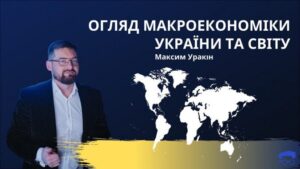
This article presents key macroeconomic indicators for Ukraine and the global economy as of the end of April 2025.
The analysis is based on current data from the State Statistics Service of Ukraine (SSSU), the National Bank of Ukraine (NBU), the International Monetary Fund (IMF), the World Bank, and leading national statistical agencies (Eurostat, BEA, NBS, ONS, TurkStat, IBGE).
Maksim Urakin, Director of Marketing and Development at Interfax-Ukraine, Candidate of Economic Sciences and founder of the Experts Club information and analytical center, presented an overview of current macroeconomic trends.
Macroeconomic indicators of Ukraine
The first four months of 2025 were marked by weak but still positive economic growth for Ukraine. According to the NBU’s estimates, real GDP grew by about +0.5% year-on-year, and the State Statistics Service’s preliminary calculations later revised the dynamics to about +0.9% year-on-year and approximately +0.7% quarter-on-quarter. In the context of full-scale war, constant threats to infrastructure and logistics, a shortage of long-term capital, and limited investment programs, this primarily means maintaining the functionality of the economic system.
“Half a percent or even a percent of growth is not about acceleration, but about endurance. We are seeing a revival of domestic demand in trade, logistics, and certain high-tech niches. But this is essentially a recovery “on the spot”: without a massive investment impulse, without an expansion of value-added exports, without accessible long-term resources, banks and businesses will not be able to scale up. We need to move from survival to development — through investment, industrial projects, and an export ecosystem,” emphasizes Maksim Urakin.
Inflationary pressure is slowly easing. Annual inflation in April was estimated at around 13.1% y/y after 14.6% in March; the National Bank kept its key rate at 15.5%, combining inflation targeting with currency market stabilization.
“Monetary policy in 2025 is about balance. If we tighten too much, we will stifle business activity and lending; if we loosen too much, we will get a new wave of inflation and pressure on the exchange rate. The NBU’s task is not simply to “hold” the rate, but to synchronize with fiscal policy, IMF programs, and the pace of external revenues so that every hryvnia of reserves works toward recovery rather than plugging operational holes,” the expert notes.
Foreign trade remains a weak link. In January–April 2025, exports of goods were estimated at about $13.31 billion, imports at about $24.82 billion, and the negative balance at about $11.51 billion. Structurally, imports are made up of energy carriers, equipment, transport, and chemicals, while exports continue to depend on raw materials and semi-finished products.
“This is not a situational but a structural deficit. As long as we import energy-intensive goods and technological components and export raw materials, the risk to the balance of payments will not disappear. The solution lies in creating production chains within the country, localizing components, advancing the development of logistics and port infrastructure, insuring military risks, and insuring export credits. We need a policy of export industrial transformation, not just “VAT refunds,” emphasizes Maksim Urakin.
International reserves remain a positive buffer, reaching a historic high of about $46.7 billion on May 1, 2025. The growth was ensured by inflows from partners and a reduction in net interventions by the NBU.
“Reserves of over $40 billion are a safety net, but they are not the country’s wealth. Reserves are a credit of trust that must be converted into industrial modernization. If we dissolve this resource in consumption and imports, it will run out, and structural problems will remain. If we direct it towards financing exports, investment insurance, infrastructure, and technology, we will get a multiplier and productivity growth,” the economist emphasizes.
The debt burden also remains high: the total public and guaranteed debt as of April 30, 2025, was estimated at about UAH 7.48 trillion (equivalent to almost $180 billion). This supports budget stability “here and now,” but makes coordination with international programs, debt restructuring, and the launch of projects that generate foreign exchange earnings critically important.
“Debt is not the enemy when it works for development. Our test of maturity is to convert debt resources into productive investments rather than consumption. We need transparent project pipelines: from feasibility studies to long-term money under state guarantees, from export insurance to industrial parks and clusters. This is the only way we will break the inertia of import dependence,” concludes the founder of Experts Club.
Global economy
At the start of the second quarter of 2025, the world is moving in a mode of moderate growth with increased uncertainty. In its April WEO, the IMF estimated global GDP growth in 2025 at around 2.8% with inflation slowly subsiding but uneven demand geography. In the US, real GDP in the first quarter, based on annualized methodology, declined by approximately 0.3% q/q due to “re-imports” and weaker government spending, while core PCE inflation in April remained at around 2.2% y/y, allowing the Fed to maintain a cautious stance.
China maintained around +5.3% y/y in the first quarter, but weakness in real estate and consumer caution limit the prospects for acceleration.
The eurozone, according to preliminary estimates at the end of April, added around +0.4% q/q (+1.2% y/y), and the EU around +0.3% q/q, showing the first signs of emerging from prolonged stagnation. The UK was a positive exception among the G7, with approximately +0.7% q/q in the first quarter. Turkey reported strong growth of around +7.4% y/y amid extremely high inflation of around 70% y/y in April, forcing the central bank to maintain a tight policy. India remains the leader among the major economies with around +7.4% y/y at the beginning of the year, with moderate CPI inflation of around 3.3% in April.
Brazil posted around +0.8% q/q (+2.6% y/y) in the first quarter, but IPCA inflation rose to around 5.5% y/y, limiting the scope for rapid policy easing.
The global picture is a mosaic of different speeds and different risks. The US is technically having a weak quarter, but domestic demand is still holding up; Europe is showing a smooth recovery without a breakthrough; China is on track for growth but needs a new model of domestic demand; India is the flagship of dynamism and innovation; Turkey has paid for its momentum with inflation; Latin America is balancing between regulation and stimulation. For Ukraine, it is not only the figures of its partners that are important, but also their policies: where they buy more steel and food, where they build logistics and energy infrastructure, where opportunities open up for suppliers of engineering products. Our task is to predict not past but future demand and occupy a niche before someone else does. This means export risk insurance, fast customs corridors, long-term money for modernization, cluster specialization, and, most importantly, discipline in execution. Without this, we will remain a country of imports and large reserves that are melting away. With this, we can become a country of exports and large projects that work,” summarizes Maksim Urakin.
Key conclusions
In summary, at the beginning of the second quarter, the Ukrainian economy is in a phase of sustained equilibrium: modest growth, slowing inflation, and record reserves are counterbalanced by a deep trade gap and high debt burden. The solution lies in accelerating structural changes: investment in industry and logistics, high value-added exports, coordination with international programs, and transforming debt resources into a driver of productivity. As Maksim Urakin emphasizes, “the window of opportunity for transformation is already open — the only question is whether we will be able to pass through it quickly enough.”
Source: https://interfax.com.ua/news/projects/1101077.html

The State Customs Service of Ukraine (SCC) has granted authorized economic operator (AEO) status with the right to apply simplifications to 100 companies, according to a press release from the SCC.
“This milestone symbolizes not only a quantitative achievement, but also qualitative progress in the development of transparent and effective cooperation between customs and business, which is an important step towards Ukraine’s integration into the European economic space,” the agency explained on its Telegram channel on Monday.
It is noted that among the Ukrainian companies that have received AEO status are manufacturers, exporters, importers, freight forwarders, and other participants in foreign economic activity (FEA).
It is noted that five companies already have both types of authorizations: “granting the right to apply simplifications” (AEO-C) and “confirming security and reliability” (AEO-B).
The GTS reminded that AEO status is a recognized mark of trust that confirms the reliability, security, and high standards of companies in the international supply chain. It gives enterprises the right to simplified customs procedures, saves time and reduces logistics costs, and, consequently, increases the competitiveness of Ukrainian businesses in the global market. For Ukraine, this means strengthening its economic potential, increasing exports, and attracting new trading partners.
For more information on AEO status and authorization to apply for simplifications, please visit https://customs.gov.ua/deiaki-pitannia-funktsionuvannia-avtorizovanikh-ekonomichnikh-operatoriv
Previously, round tables were dedicated to customs reform, where event organizer and moderator Maksim Urakin stated that the State Customs Service provides up to 40% of Ukraine’s state budget revenues, with these figures remaining stable over the past few years. That is why customs reforms are so important for the country.

The Experts Club Information and Analytical Center analyzed updated data on Ukraine’s foreign trade volumes for the first half of 2025, published by the State Statistics Service of Ukraine. The analysis is based on official customs statistics and covers 49 of Ukraine’s main trading partners from all continents. The study revealed key trends in foreign economic relations that demonstrate the depth of the country’s international integration.
China remains Ukraine’s largest trading partner, with a total trade volume of nearly US$9 billion. This is more than three times higher than the figures for any individual European country. Poland ranks second with a result of over US$6 billion, demonstrating its stable role as the main European hub for Ukrainian exports and imports. Germany ranks third with a volume of US$4.28 billion.
Turkey ($4.25 billion) and the US ($2.86 billion) also made it into the top five, reflecting the broad geography of Ukraine’s trade relations.
European countries traditionally play a leading role in Ukraine’s foreign trade. Among them, in addition to Poland and Germany, Italy, the Czech Republic, Bulgaria, Hungary, and Romania are worth noting — all of them are among the top 10 partners. High indicators testify not only to the volume of trade, but also to the stability of logistics and production chains in the region.
This also confirms the gradual reformatting of Ukraine’s foreign trade orientation towards EU markets, particularly after the introduction of a duty-free regime, accession to the single customs space, and reorientation from traditional post-Soviet markets.
Among Asian countries, China remains the undisputed leader, retaining its strategic importance as a market for raw materials and a source of industrial imports. Turkey, although part of the Eurasian space, is actively strengthening its position in trade thanks to its flexible policy and developed logistics through the Black Sea.
Among other Asian players, the Republic of Korea, Japan, and India are notable for their presence, gradually increasing trade volumes with Ukraine, especially in the high-tech and pharmaceutical segments.
The United States remains Ukraine’s most important partner in the Western Hemisphere. Despite its geographical distance, the US is among the top five trading partners with a volume of over $2.85 billion. This testifies to deep economic interaction that complements political and defense partnerships.
Brazil and Mexico are also represented in the overall ranking, demonstrating growth in trade volumes, primarily in the agricultural and industrial goods segments.
They are increasingly appearing in Ukraine’s trade balance. In particular, Algeria, Egypt, Tunisia, and Libya show stable demand for Ukrainian grain, metallurgical products, and machine-building products. At the same time, the potential of African markets for Ukrainian exports remains significant and can be realized under conditions of expanded logistics routes and political stability.
Top 10 trading partners of Ukraine in January–June 2025
No. Country Trade volume (USD million)
1 China 8,996
2 Poland 6,043
3 Germany 4,279
4 Turkey 4,249
5 United States 2,859
6 Italy 2,384
7 Czech Republic 1,641
8 Bulgaria 1,539
9 Hungary 1,526
10 Romania 1,499
“The latest foreign trade data demonstrate not only the geographical diversification of Ukraine’s partners, but also a clear focus on integration into the European and global markets. Despite the difficult security situation, Ukrainian business continues to expand into international economic chains, especially in the fields of agricultural products, metallurgy, and machine building. Significant growth in trade with EU countries and the US, as well as strong cooperation with China and Turkey, show that Ukraine has not lost its ability to be an active player in the global market,” says Maxim Urakin, founder of Experts Club and candidate of economic sciences.
Data for the first half of 2025 indicate that Ukraine’s foreign economic relations remain geographically diverse. The EU remains a reliable economic partner, China retains its position as the No. 1 global player, and North American and Asian countries are strengthening their roles. Africa is a promising direction that requires strategic attention.
Analyse, ANALYTICS, ECONOMICS, EXPERTS CLUB, Handel, TRADE, URACIN, URAKIN, WIRTSCHAFT

Brazil’s Ministry of Finance has raised its GDP growth forecast for 2025, but expects the economic upturn to slow down as a result of the country’s central bank’s tight monetary policy.
The GDP growth forecast for the current year has been raised to 2.5% from the 2.4% expected in May, and for 2026 it has been lowered to 2.4% from 2.5%.
The forecasts do not take into account the consequences of Washington’s introduction of 50% tariffs on all imports from Brazil, the Ministry of Finance notes. Earlier, US President Donald Trump announced that these tariffs would take effect on August 1.
“The tariffs are unlikely to have a significant impact on GDP growth in 2025, although certain industries may suffer quite severely,” the Ministry of Finance said in a statement.
In the first quarter of this year, Brazil’s GDP increased by 1.4% compared to the previous three months, the highest in three quarters. GDP growth in annual terms was 2.9%.
Earlier, the Experts Club information and analytical center made a video analysis of the prospects for the Ukrainian and global economies. For more details, see the video at https://youtu.be/kQsH3lUvMKo?si=F4IOLdLuVbYmEh5P

In the first half of 2025, the Ukrainian economy demonstrates fragile but positive growth, despite the difficult external environment and high dependence on international financial support. This is stated in an analytical review published by the Experts Club information and analytical center on YouTube.
“We are seeing a cautious but still positive signal: Ukraine’s economy is growing, albeit very slowly. The National Bank forecasts GDP growth of 2.5-3.1% in 2025. This is above the survival line, but not enough for a full recovery,” said Maksym Urakin, PhD in Economics and founder of Experts Club.
“Inflation remains at 12-13%, which continues to reduce the purchasing power of the population. Despite the NBU’s moderate monetary policy, the pressure on households remains,” the economist explained.
The situation in foreign trade also remains alarming. In May 2025, the trade deficit in goods and services reached $4.1 billion. Imports amounted to $7 billion, while exports were only $3.4 billion. Trade in services also has a negative balance – $1.8 billion against $1.3 billion.
“The structure of exports shows changes. Supplies of pharmaceuticals, wood and live animals are growing, but grain exports have fallen by almost a quarter. And this is even before the loss of possible EUR 3.5 billion in revenues due to the end of EU customs privileges,” emphasizes Urakin.
At the same time, Ukraine’s international reserves have increased – as of June 1, they amounted to $44.54 billion. This is more than at the end of 2024, although it is 4.6% less than in April. But the public debt, according to Urakin, remains critically high – $179.2 billion (about 94% of GDP), of which more than $134 billion are external liabilities.
“The reserves are currently sufficient to stabilize the exchange rate and payments. But this is a resource that cannot be exhausted indefinitely. Ukraine remains critically dependent on international assistance – from the IMF, the EU and other partners,” he emphasized.
The global economy, according to the IMF and the World Bank, is expected to show the slowest growth in the last decade in 2025, at 2.3-2.8%. Inflationary pressures, trade disputes, and geopolitical instability are limiting the potential for global recovery. The Bank for International Settlements describes the situation as a “turning point” due to protectionism, declining productivity, and demographic risks.
The United States recorded its first decline in GDP since 2022, down 0.5% year-on-year in the first quarter. The main reasons are weakening consumer demand and declining exports. However, the Atlanta Fed predicts a recovery – 2.5% growth in the second quarter. PCE inflation is 3.1%, core inflation is 2.6%, and the Fed’s key policy rate remains at 5.25-5.5%.
In China, the economy grew by 5.4% in the first quarter. However, the official PMI in June remained below the 50 mark (49.7), indicating instability in the industry. Meanwhile, the private Caixin PMI exceeded 50 for the first time in several months.
The Eurozone is showing signs of stabilization: in the first quarter, GDP grew by 0.6% y-o-y, inflation in June was exactly 2%, i.e. within the ECB’s target. Manufacturing indices are also improving. Germany is still feeling the effects of the last recession. The GDP growth forecast is only 0.3-0.4%, although the manufacturing PMI has exceeded 50 for the first time since 2022. Retail trade, however, remains weak.
The UK surprised with positive dynamics – 0.7% growth in the first quarter, the highest among the G7. Inflation in May was 3.4%, with the Bank of England’s key policy rate at 4.25%.
India continues to lead the way in terms of growth – 7.4% in the first quarter. Inflation was only 2.82%. The central bank cut its key policy rate to 5.5% in response to lower inflationary pressures.
Brazil is expected to grow at 2.1-2.4%, but inflation in May was 5.32%. This forced the regulator to maintain the high Selic rate of 15%.
Japan is showing the first signs of recovery. The PMI in industry reached 50.1, and the composite PMI – 51.4. Inflation in services is 3.3%, and the Bank of Japan may raise rates as early as 2026.
“The global economy is in a turning point. The US and Europe are stagnating, while China is recovering cautiously. Germany and the UK are showing weak but stable growth. India remains the engine of global development. For Ukraine, the main thing is not to lose momentum, maintain access to international financing and adapt to the new conditions of global trade,” summarized Maksym Urakin.
The material was prepared based on the analytical review by Experts Club. Watch the video for more details at the link: https://www.youtube.com/watch?v=kQsH3lUvMKo&t
You can subscribe to the Experts Club YouTube channel here: https://www.youtube.com/@ExpertsClub

Over the past three decades, pig farming has remained one of the most important components of global agricultural production. It has played a key role in providing the population with animal protein, shaping export flows in Asia and Europe, while remaining vulnerable to global epidemiological risks. Experts Club analysts have studied changes in the global pig population between 1990 and 2023.
“Pig farming is an industry where economics is closely intertwined with biological risks. It is extremely profitable in stable conditions, but it instantly suffers from any disruptions in the veterinary or logistics chain,” said Maxim Urakin, PhD in Economics and founder of the Experts Club information and analytical center.
In the early 1990s, the total number of pigs in the world grew steadily, especially in China, which became the largest producer and consumer of pork. Mass industrial production, urbanization, and high demand for meat in the Asia-Pacific region stimulated capacity expansion. By the mid-2010s, the industry was at its peak: in some years, the number of pigs in the world exceeded one billion. This dynamic reflected the successful commercialization of the industry in China, Vietnam, Brazil, the United States, Germany, and Spain.
However, after 2018, the global pig industry faced one of the most significant challenges in recent decades — the African swine fever (ASF) pandemic. The epizootic, which began in China, spread to dozens of countries and led to a massive reduction in livestock numbers. In China alone, it is estimated that more than 100 million pigs were destroyed. This caused a meat shortage in the global market, price increases, a crisis in feed chains, and a reorientation of international trade.
“After the ASF outbreak, China began to actively reform the structure of pig farming, moving from small farms to large biosecure complexes. This also affected the global market, as demand for safe and controlled meat rose sharply,” Urakin explained.
Europe, in turn, found itself under pressure from environmental legislation and growing animal welfare requirements. In the Netherlands, Denmark, and Germany, the industry declined not only due to disease but also due to political decisions to reduce methane and nitrate emissions. In North America, the situation remained stable, although it was affected by tariff wars, especially in US-China relations.
Today, the global pig industry has partially recovered but remains in a phase of restructuring. China is gradually restoring its livestock population, but on new principles — with strict control of biosecurity, genetics, and investment in innovation. At the same time, more and more countries are investing in alternative proteins — cultured meat and plant-based pork substitutes — which poses long-term risks to the traditional industry.
“The future of pig farming is a symbiosis of biotechnology, sustainable management, and veterinary reliability. Those who cannot adapt will lose the market,” concluded Maxim Urakin.
A detailed analysis of the situation on the pork market and a visualization of global trends can be found in a special video review on the Experts Club YouTube channel.
AGRICULTURAL MARKET, ANIMAL HUSBANDRY, EXPERTS_CLUB, PIG FARMING, URAKIN